When seeking relief through pressure points for digestion, it’s vital to understand how acupressure, a foundational aspect of Traditional Chinese Medicine (TCM), can be beneficial. This technique, which involves applying targeted pressure on specific body points, can significantly improve your digestive health. For your convenience, here’s a quick reference table featuring key acupressure points, including Ren-12 and LI-4, which TCM Therapist Ms. Mai Sogawa highly recommends. Each point in the table is linked for more detailed information.
Pressure Points For Digestion
| Acupressure Point | Location | Benefits & Techniques |
|---|---|---|
| Ren-12 | Midpoint between the navel and the bone just above the stomach. | Balances the Stomach meridian’s qi flow. Technique: Apply gentle pressure for 5 seconds; expect a firm sensation or pain in cases of bloating/stomach pain. (Recommended by Ms. Mai Sogawa) |
| LI-4 | On the back of the hand, where the bones of the thumb and index finger meet. | Enhances qi flow in the Large Intestine. Technique: Apply pressure for 5 seconds until a heavy, throbbing pain is felt. (Recommended by Ms. Mai Sogawa) |
| ST-36 | Four fingers below the kneecap, outside the shin bone. | Strengthens the stomach and spleen, eases indigestion. |
| HT-7 | On the wrist crease at the side of the little finger. | Calms the mind, improves intestinal movement. |
| LI-11 | At the edge of the crease on the flexed elbow. | Regulates qi and blood, effective for gastrointestinal issues. |
| SP-6 | Four finger-widths above the inner ankle bone. | Strengthens spleen and stomach, harmonizes liver. |
| PC-8 | In the middle of the palm, between the second and third metacarpal bones. | Regulates autonomic nervous system, relieves mental fatigue. |
| Liv-3 | In the depression between the bones of the big toe and the next toe. | Moves qi and blood throughout the body, treats headaches and vertigo. |
| KI-1 | On the sole of the foot, in the depression when toes are bent backward. | Regulates the autonomic nervous system, relieves stomach upset caused by stress. |
Acupoint: Ren-12 (Other Names: The Conception Vessel-12/Zhong Wan/Middle Epigastrium)

- Location: Midpoint between the navel and the bone just above the stomach.
- Importance: Ren-12 serves as a confluence point for the Stomach meridian, a crucial area for the accumulation of qi.
- Benefits: Stimulating this point helps balance the qi flow in the Stomach meridian, vital for digestion.
- Technique for Stimulation: Apply slow, gentle pressure for about 5 seconds, seeking a firm sensation or pain, particularly if experiencing bloating or stomach pain.
Acupoint: LI-4 (Other Names: Large Intestine-4/He Gu/Joining Valley)

- Location: On the back of the hand, where the bones of the thumb and index finger meet.
- Importance: LI-4 is the source point for the Large Intestine meridian, a key area for original qi accumulation.
- Benefits: Pressure on this point enhances qi flow in the Large Intestine, positively influencing digestion.
- Technique for Stimulation: Gently apply pressure for 5 seconds, aiming for a heavy, throbbing pain to ensure correct application.
Acupoint: ST-36 (Other Names: Stomach-36/Zu San Li/Leg Three Miles)

The first of the pressure points for digestion on the list is the stomach meridian acupoint, ST-36. Zusanli, as it is called in Chinese, is located on the leg, making it one of the pressure points on the feet for digestion. To locate this acupoint, bend your knee slightly, then place four fingers beneath your kneecap. The point outside the shin bone where the little finger rests is ST-36.
In TCM, ST-36 is regarded as one of the most important pressure points to tonify Qi and Blood and promote general health and wellness. In addition, it eases indigestion and gastrointestinal fatigue as well as strengthens the spleen and stomach.
Based on these functions, Zusanli is effectively used as acupressure for stomach pain in the child. It is the right acupoint for treating gastric pain, abdominal distention, constipation, and diarrhea. For the best result, it is recommended that you massage not just the acupoint but also the area around ST-36.
Acupoint: HT-7 (Other Names: Heart-7/Shen Men/Spirit Gate)
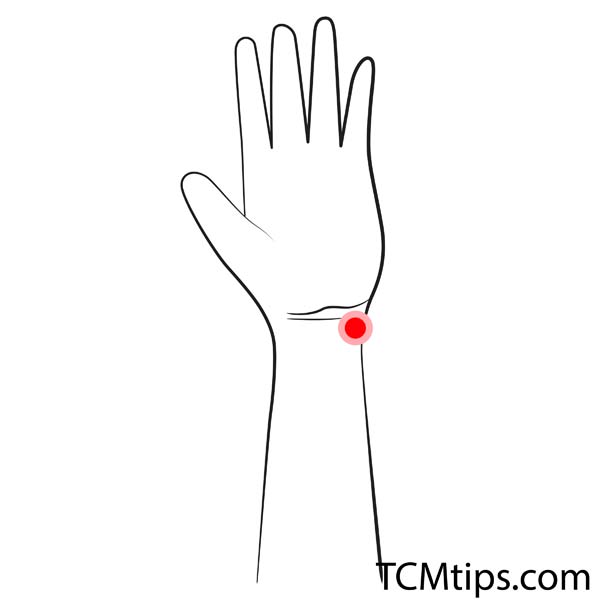
The next acupressure for digestion is the heart meridian acupoint, HT-7. Called Shenmen in Chinese, which translates to Spirit Gate, HT-7 is located on the hands. You’ll find it in the depression on the wrist crease at the side of the little finger.
As the Spirit Gate, this acupoint functions to calm the Shen and tonify and regulate the heart, blood, and qi. It also helps to improve the autonomic nerves and boost intestinal movement.
HT-7 is popularly used as acupressure for children as well as acupressure for insomnia, cardiac pain, chest pain, and amnesia. TCM practitioners see it as the best pressure point for emotional issues.
Acupoint: LI-11 (Other Names: Large Intestine-11/Qu Chi/Pool at the Crook)
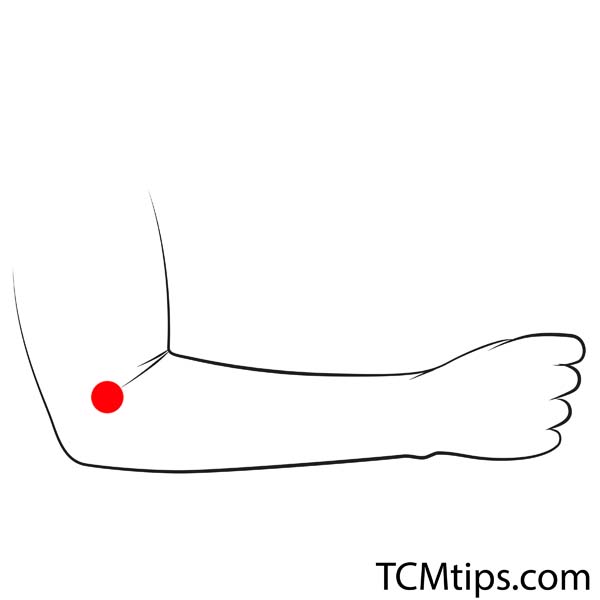
ST-11 or Quchi as it is referred to in Chinese, is another acupoint that serves effectively as acupressure for digestive problems. Quchi is located on the hands. To find it, flex your elbow. The point at the edge of the crease that forms when you flex your elbow is ST-11.
In TCM, this acupressure point for digestion on the hand is responsible for clearing heat, cooling the blood, resolving dampness, expelling exterior wind, and regulating the Qi and Blood. Quchi is classified as a He-Sea point, which makes it effective for treating rebellious qi issues and diarrhea.
Clinically, ST-11 is the acupoint to press for abdominal pain, irregular menstruation, diarrhea, vomiting, blurry vision, and malaria. It also serves effectively as one of the acupressure points for cold hands and feet.
Acupoint: SP-6 (Other Names: Spleen-6/San Yin Jiao/Three Yin Intersection)
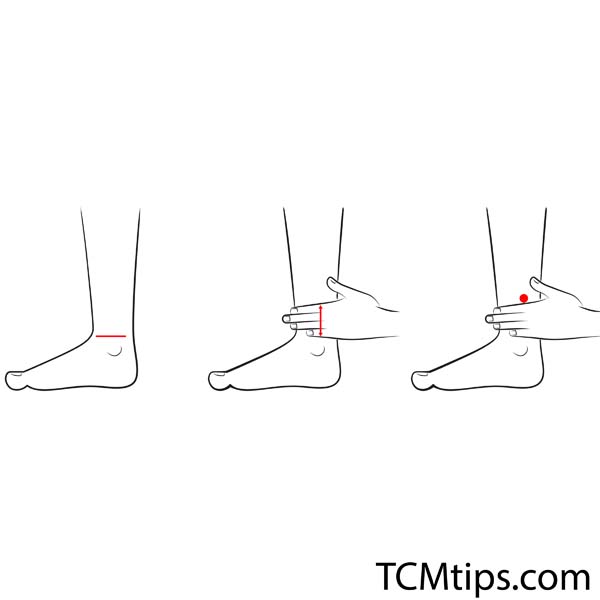
The next acupressure for digestive problems that you should know is the spleen acupoint, SP-6. Known as Sanyinjiao in Chinese, which interprets as Three Yin Intersection, this acupoint is located on the leg and is the point where the liver, spleen, and kidney meridians meet, hence the name. You’ll find SP-6 four finger-width above the inner ankle bone.
In Oriental medicine, SP-6 is responsible for strengthening the spleen, stomach, and kidney; resolving dampness; harmonizing the liver; nourishing the blood, and regulating menstruation. It is an effective acupoint to boost digestive function and treat gynecological symptoms.
Based on these functions, SP-6 is used clinically to treat irregular menstruation, infertility, nocturnal emission, muscular pain, abdominal distention, and diseases of the skin. It also serves as acupuncture for swollen ankles.
Acupoint: PC-8 (Other Names: Pericardium-8/Lao Gong/Palace of Toil)
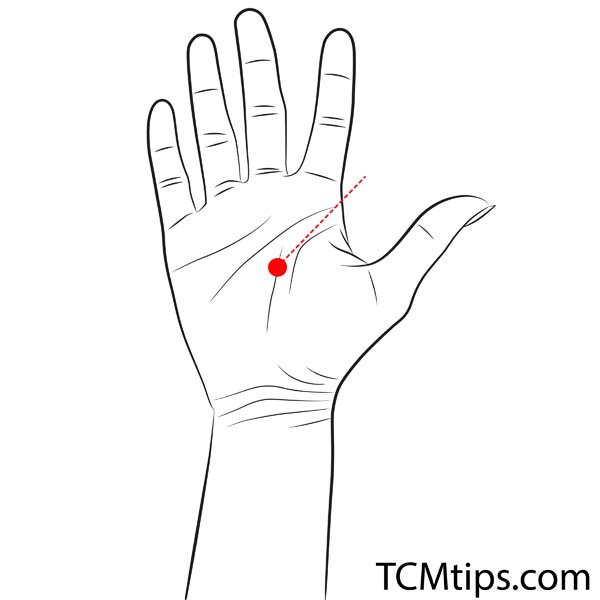
The next pressure point for digestion that you should know is the Pericardium meridian acupoint, PC-8. This acupoint is called Laogong in Chinese, which means Labor Place. You’ll find PC-8 in the middle of the palm, between the second and third metacarpal bones, at the point where the tip of the middle finger rests when you make a fist.
Laogong is an acupoint that promotes the flow of blood and oxygen throughout the body. It promotes muscle recovery and activates the brain. Hence it is regarded in TCM as the pressure point to effectively regulate the autonomic nervous system and relieve mental fatigue such as stress and frustration.
PC-8 is the right pressure point to stimulate when you have hot flashes in your hands, tightness of the chest, and gastrointestinal issues. It serves as one of the acupressure points for speech development as well as one of the points for depression.
Acupoint: Liv-3 (Other Names: Liver-3/Tai Chong/Supreme Rush)

The second to the last pressure point for digestive issues on my list is the liver meridian acupoint, LIv-3. Referred to as Taichong in Chinese, this popular pressure point is located on the feet. You’ll find it in the depression between the bones of the big toe and the next toe.
The liver is very vital to health in Oriental medicine as it is responsible for maintaining internal balance. The liver meridian regulates the liver and creates a flow of blood and qi that moves from the big toe, through the inside of the leg, past the reproductive organs, liver, mammary glands, and thyroid, to the top of the head.
This pressure point on the feet for digestion, when coupled with LI-4 easily moves Qi and Blood throughout the body. Liv-3 serves as an effective acupressure treatment for headaches, vertigo, numbness of the lower extremities, and epilepsy. Based on its functions, it also works as one of the acupressure points for the brain.
Acupoint: KI-1 (Other Names: Kidney-1/Yong Quan/Gushing Spring)
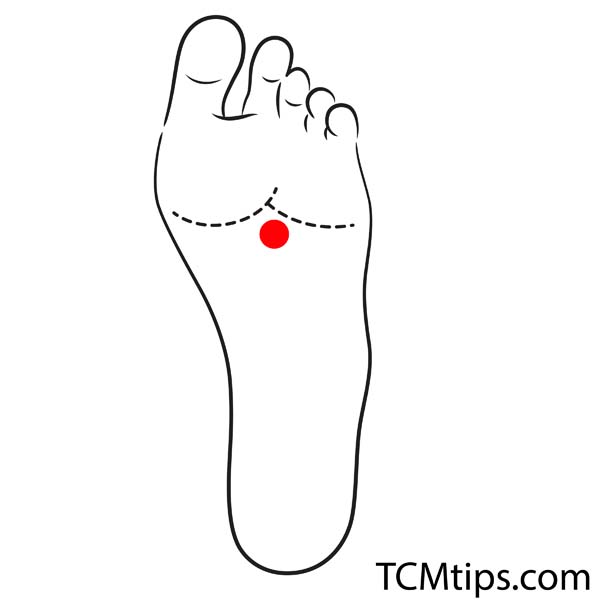
Finally, the last of the pressure points for digestion on our list that is worthy of note is KI-1. This Kidney meridian acupoint is called Yongquan in Chinese, which means Gushing Spring. It is located at the sole of the feet. To locate it, bend your toes backward. The point where a dent forms on the sole of your feet between the web of the second and third toes is KI-1.
In Oriental medicine, KI-1 is responsible for regulating the autonomic nervous system and relieving stomach upset caused by stress and cold. When you press this acupoint that effectively serves as acupressure for bloating, it eases intestinal tension. This is why KI-1 is also used to treat constipation, nausea, vomiting, as well as loss of consciousness, and dizziness. You can also use it for acupuncture for hair thinning.
To get the best result, apply firm pressure with your thumb on this pressure point. Push it slowly for 3 seconds, stop, and repeat 3 to 5 times on both feet. Try not to push too hard because it would activate the sympathetic nerves, making you lose the calming effect of the massage.
Does Acupressure Help With Digestion?
Yes, acupuncture helps with digestion. The way acupuncture treatment for digestion works is by nourishing the organs necessary for digestion, reducing stomach and pancreas inflammation, and improving digestive functions. During acupuncture for digestion treatment, the acupuncture practitioner will identify pressure points on the body that will speed up metabolism, boost gastrointestinal muscle contraction and relaxation, reduce gastric acid secretion, regulate small and large intestine function, and bring back stomach acidity to normal levels.
Scientific evidence exists to support acupuncture and digestion. A 2002 research analyzing whether acupuncture for gastrointestinal disorders is a myth or magic cited pilot studies that proved the effectiveness of acupuncture for digestive issues such as nausea, vomiting, irritable bowel syndrome, constipation, and diarrhea.
Safety and Precautions: When to Seek Medical Care
Times to Avoid Acupressure
- After Eating or Drinking Alcohol: Avoid acupressure for at least 30 minutes post-meal to prevent discomfort or dizziness.
- Pregnancy: Pregnant individuals or those possibly pregnant should refrain from these practices.
Potential Risks and Side Effects
- Warning Signs: Look out for symptoms like unbearable pain, palpitations, sweating, fever, or prolonged discomfort.
- Consultation: Immediate medical advice is recommended if such symptoms are experienced.
When to Seek Medical Care
- Persistent Digestive Issues: Consult a healthcare professional if digestive problems continue despite acupressure.
- Underlying Conditions: Medical advice is crucial if an underlying health condition might be affecting digestive health.

Try our Anti-Aging Gua Sha Tool designed to bring out your skin’s natural glow.
Best Gua Sha Product- Anti-Aging: The tool is designed to target 11 specific aging signs such as wrinkles and sagging skin. By following the 7-step routine, users can improve skin firmness and reduce fine lines naturally.
- Enhances Skincare Routine: It works effectively with serums and lotions, boosting absorption and efficacy of skincare products.
- Visible Skin Improvement: Users can expect a smoother complexion, reduced puffiness, and a more youthful appearance.
 P. Sze
P. Sze 

















